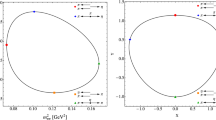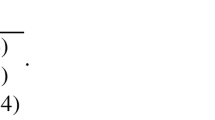Summary
A pole expansion of Veneziano four-point amplitudes which is convergent in the annihilation channel is useda) to analyse the resonance content of the previously proposed dual descriptions of the reaction\(\bar p\)n → π+π−π− at rest, andb) to construct a dual model for this reaction which exhibits a clear connection to the final-state interaction model. The important predictions of duality and crossing symmetry are the existence of the daughter resonances in the ππ system (particularly ɛ and ɛ′), and the presence of a nonresonant background in the annihilation amplitude. A reasonable fit to the data is found with this model.
Riassunto
Si usa uno sviluppo polare delle ampiezze di quattro punti di Veneziano convergente nel canale di annichilazione pera) analizzare il contenuto di risonanze della descrizione duale della reazione\(\bar p\)n → π+π−π− in quiete proposto precedentemente, eb) costruire un modello duale di questa reazione che presenti una chiara connessione col modello di interazione dello stato finale. Le predizioni importanti della dualità e della simmetria incrociata sono l’esistenza delle risonanze figlie nel sistema ππ (in particolare ɛ e ɛ′) e la presenza di un fondo non risonante nell’ampiezza di annichilazione. Con questo modello si trova una ragionevole approssimazione ai dati.
Similar content being viewed by others
References
See, for example,J. D. Jackson: inProceedings of the Lund International Conference on Elementary Particles (Lund, 1969), p. 96. Also see the references below.
P. Anninos, L. Gray, P. Hagerty, T. Kalogeropoulos, S. Zenone, R. Bizzarri, C. Ciapetti, M. Gaspero, I. Laakso, S. Lichtman andG. C. Moneti:Phys. Rev. Lett.,20, 402 (1968).
See also ref. (3). Strictly speaking, the model there violates the final-state interaction theorem. Nevertheless, it provides a description of the annihilation in terms of resonance poles.
A. Gleeson, W. Meggs andM. Parkinson:Phys. Rev. Lett.,25, 74 (1970).
C. Lovelace:Phys. Lett.,28 B, 265 (1968).
C. Altarelli andH. Rubinstein:Phys. Rev.,183, 1469 (1969).
G. P. Gopal, R. Migneron andA. Rothery:Phys. Rev. D,3, 2262 (1971); and Imperial College preprint ICTP/69/24 (Sept. 1970).
R. Odorico:Phys. Lett.,33 B, 489 (1970).
S. Pokorski andG. H. Thomas: University of Helsinki preprint TFT 17-70 (October 1970).
J. Boguta:Nucl. Phys.,13 B, 577 (1969); Bonn University preprint (December 1969).
AC 22-term is included here sinceB 5 models for annihilation would in general contain these terms, unless specific assumptions about satellite terms are made. We thank Dr.M. Chaichian and Prof.H. R. Rubinstein for several communications concerning theirB 5-model (10).
H. Rubinstein, E. Squires andM. Chaichian:Phys. Lett.,30 B, 189 (1969).
F. James andM. Roos: CERN Program Library.
S. Pokorski, M. Szeptycka andA. Zieminski:Nucl. Phys.,27 B, 568 (1971).
Chan Hong-Mo, R. O. Raitio, G. H. Thomas andN. A. Törnqvist:Nucl. Phys.,19 B, 173 (1970).
Author information
Authors and Affiliations
Additional information
To speed up publication, the authors of this paper have agreed to not receive the proofs for correction.
Rights and permissions
About this article
Cite this article
Pokorski, S., Raitio, R.O. & Thomas, G.H. Duality and final-state interaction in the description of\(\bar p\)n → π+π−π− at rest. Nuov Cim A 7, 828–838 (1972). https://doi.org/10.1007/BF02728813
Received:
Published:
Issue Date:
DOI: https://doi.org/10.1007/BF02728813




